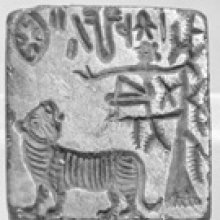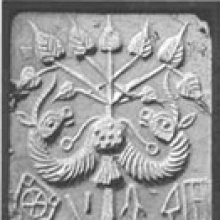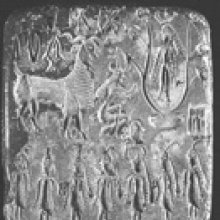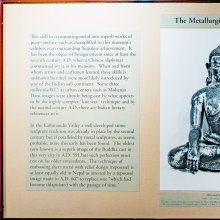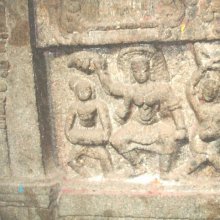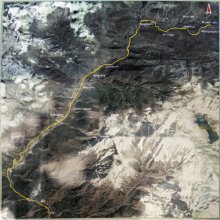Mohenjo-daro, Mohenjodaro: 3 definitions
Introduction:
Mohenjo-daro means something in Hinduism, Sanskrit, the history of ancient India. If you want to know the exact meaning, history, etymology or English translation of this term then check out the descriptions on this page. Add your comment or reference to a book if you want to contribute to this summary article.
Images (photo gallery)
In Hinduism
Shilpashastra (iconography)
Source: Shodhganga: The significance of the mūla-beras (śilpa)Mohenjodaro and sculptures.—The bronze image of a dancing girl measuring four inches in height, found in Mohenjodaro, is a good example of the remarkable achievement of the Indus artist in metallurgy. The pose is well defined and all the features are modeled in an artistic way. There are male figures in yogāsana postures. The closing narrow eyes of the male figure that is fixed on the tip of the nose and the namaskara-mudrā (añjali-hasta) bring out the attitude of the Yogī.

Shilpashastra (शिल्पशास्त्र, śilpaśāstra) represents the ancient Indian science (shastra) of creative arts (shilpa) such as sculpture, iconography and painting. Closely related to Vastushastra (architecture), they often share the same literature.
India history and geography
Source: Knowledge Traditions & Practices of India: Architecture (1): Early and Classical Architecture (h)Mohenjo-daro (or Mohenjodaro) is an important archaeological site dating from the Harappan civilization.—Complex structures, such as Mohenjo-daro’s Great Bath or the so-called Granary, demonstrated advanced planning and construction skills. In the Great Bath’s central basin, for example, the floor was made of tightly fitted bricks set on edge and cemented with a gypsum plaster to make a watertight surface; it was then covered with a layer of bitumen (natural tar).
Source: Shodhganga: Elements of Art and Architecture in the Trtiyakhanda of the Visnudharmottarapurana (history)Mohenjo-Daro refers to a certain period in the history of Indian Art.—The chronological order of the development of Indian Art as stated in The Heritage of Indian Art is as follows—[...] 1. Mohenjo-Daro and Harappa are the chief centers of Indus valley Art and culture and these two civilizations belong to 3000-2250 B.C. The people of the Indus valley civilization seems to be very creative in the arts of house-building, stone and clay statuary, bronze casting, making of ornaments of gold and silver, ivory carving, weaving etc.

The history of India traces the identification of countries, villages, towns and other regions of India, as well as mythology, zoology, royal dynasties, rulers, tribes, local festivities and traditions and regional languages. Ancient India enjoyed religious freedom and encourages the path of Dharma, a concept common to Buddhism, Hinduism, and Jainism.
See also (Relevant definitions)
Partial matches: Daro.
Full-text: Harappa, Indus Valley, Lothal, Indian Architecture, Kalibangan, Rakhigarhi, Bhirrana, Farmana, Vastushastra, Dholavira, Indian Art.
Relevant text
Search found 25 books and stories containing Mohenjo-daro, Mohenjodaro; (plurals include: daros, Mohenjodaros). You can also click to the full overview containing English textual excerpts. Below are direct links for the most relevant articles:
Lord Jhulelal: An Analytical Study (by Thakkar Harish Gopalji)
Part 14 - Ancient Sindh and Sindhi People < [Chapter 2 - Literature Review]
Part 15 - Advancement in Civil Engineering < [Chapter 2 - Literature Review]
Part 5.6 - The Sindh Story < [Chapter 2 - Literature Review]
Complete works of Swami Abhedananda (by Swami Prajnanananda)
Appendix 1 - Prehistoric Indus Civilization < [Discourse 1 - India and Her People]
Appendix 2 - Indian Art in all its Phases < [Discourse 1 - India and Her People]
Vastu-shastra (1): Canons of Architecture (by D. N. Shukla)
(i) Origin of Indian architecture < [Chapter 4 - An outline History of Hindu Architecture]
(viii) Conclusion < [Chapter 5 - Study of Hindu Science of Architecture]
Kamashastra Discourse (Life in Ancient India) (by Nidheesh Kannan B.)
1. Formational Backdrop < [Chapter 1 - Rise of Urbanization and Luxury Life in India]
Rivers in Ancient India (study) (by Archana Sarma)
1. The river Sarasvatī and its Present Status < [Chapter 6 - Changing trends of the Rivers from Vedic to Purāṇic Age]
Lakulisha-Pashupata (Philosophy and Practice) (by Geetika Kaw Kher)
Prologue < [Introduction]
Historicity (of the term linga) < [Chapter 6 - Siva-linga: an Iconological Study]
Related products
